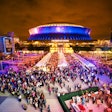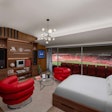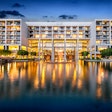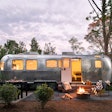
Last night, the Ravens beat the 49ers in Super Bowl XLVII. And terrifyingly for event professionals watching the game, the New Orleans Superdome lost power for 34 minutes after Beyoncé's halftime show. How do you prevent that nightmare scenario from happening to you? Here are eight tips from lighting and power pros that will give you the best tools possible for avoiding blackouts.
1. Plan for redundancy.
This is the key. Yes, it adds to the budget, but last night's blackout was a major reminder of the importance of building in total redundancy when the stakes are high. Pay for generators, and make sure they're set up and ready to go for any contingency.
"My first preference is using redundant backup generators, two generators that run simultaneously, sharing the load. If one fails, the other takes on its load. This allows for zero dark or downtime," says Images by Lighting's Ray Thompson. "The second scenario is a standard generator with a backup. In order to minimize the downtime, request a transfer switch. Instead of physically moving cables from one generator to the next, it's just a matter of throwing a switch that transfers the load to the backup. This can save minutes, which seem like hours when you are in the dark."
2. Know how much of a venue's total power is usable.
You may be working in a massive venue that you know has major power on site—like a football stadium. But you might not be able to use all of it, unless you plan ahead. "Some power at those venues can be in a higher voltage," says SMS Generators general manager Daniel Wachs. "Make it usable by renting a transformer to reduce the voltage on site, for instance. That's easily done as long as there's a little bit of planning."
3. Just because you can plug it in doesn't mean you can power it.
If you overload the wall and add a bunch of power strips, you risk tripping the breakers and shutting everything down. "Sometimes planners think that as long as they can get their plugs in the wall, or into the power strip, they'll be OK," Wachs says. "But stuff can take more power than you think."
4. Plan for more power than you need.
Wachs says his team at SMS Generators always plans for 20 percent more power than is actually needed to create "a nice buffer zone" and steer far clear of catastrophe.
5. Defer to an expert.
Especially when the stakes are high, have an expert on site dedicated to understanding the event's power needs and availability. "When doing a site survey, try to include your power vendor in the conversation," Wachs says.
6. Bring a backup lighting board.
As well as for backup power, budget for a backup lighting board. "So many events are controlled by conventional as well as intelligent lighting boards," Thompson says. "If the board fails, the lighting system quite often shuts down."
7. Don't get blinded by the event's more glamorous details.
Sure, the Super Bowl is among the highest-profile events of the year. But like any event, it required attention to decidedly unglamorous details, like power. "Don't go for the fancy platters and plates and forget something important like bathrooms or power," Wachs says. "With a little bit of forethought and budgeting ahead of time, you can avoid some major event disasters."
8. Hedge your bets.
OK, let's say you do lose some house power, and the majority of the event is running off of one generator. With some little aesthetic tricks, your guests can still be comfortable. "I recommend putting something like the pin spots or some of the area lighting on house power," Thompson says. "In the event the generator failed, your guests would have light to eat or safely exit."



















